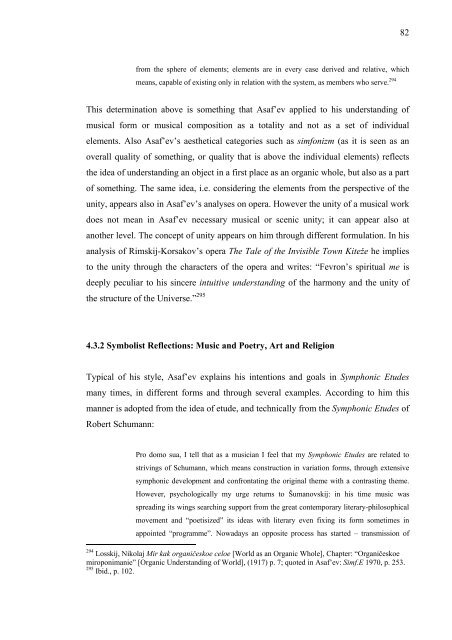Boris Asaf'ev and the Soviet Musicology - E-thesis
Boris Asaf'ev and the Soviet Musicology - E-thesis
Boris Asaf'ev and the Soviet Musicology - E-thesis
Create successful ePaper yourself
Turn your PDF publications into a flip-book with our unique Google optimized e-Paper software.
from <strong>the</strong> sphere of elements; elements are in every case derived <strong>and</strong> relative, which<br />
means, capable of existing only in relation with <strong>the</strong> system, as members who serve. 294<br />
This determination above is something that Asaf’ev applied to his underst<strong>and</strong>ing of<br />
musical form or musical composition as a totality <strong>and</strong> not as a set of individual<br />
elements. Also Asaf’ev’s aes<strong>the</strong>tical categories such as simfonizm (as it is seen as an<br />
overall quality of something, or quality that is above <strong>the</strong> individual elements) reflects<br />
<strong>the</strong> idea of underst<strong>and</strong>ing an object in a first place as an organic whole, but also as a part<br />
of something. The same idea, i.e. considering <strong>the</strong> elements from <strong>the</strong> perspective of <strong>the</strong><br />
unity, appears also in Asaf’ev’s analyses on opera. However <strong>the</strong> unity of a musical work<br />
does not mean in Asaf’ev necessary musical or scenic unity; it can appear also at<br />
ano<strong>the</strong>r level. The concept of unity appears on him through different formulation. In his<br />
analysis of Rimskij-Korsakov’s opera The Tale of <strong>the</strong> Invisible Town Kiteže he implies<br />
to <strong>the</strong> unity through <strong>the</strong> characters of <strong>the</strong> opera <strong>and</strong> writes: “Fevron’s spiritual me is<br />
deeply peculiar to his sincere intuitive underst<strong>and</strong>ing of <strong>the</strong> harmony <strong>and</strong> <strong>the</strong> unity of<br />
<strong>the</strong> structure of <strong>the</strong> Universe.” 295<br />
4.3.2 Symbolist Reflections: Music <strong>and</strong> Poetry, Art <strong>and</strong> Religion<br />
Typical of his style, Asaf’ev explains his intentions <strong>and</strong> goals in Symphonic Etudes<br />
many times, in different forms <strong>and</strong> through several examples. According to him this<br />
manner is adopted from <strong>the</strong> idea of etude, <strong>and</strong> technically from <strong>the</strong> Symphonic Etudes of<br />
Robert Schumann:<br />
Pro domo sua, I tell that as a musician I feel that my Symphonic Etudes are related to<br />
strivings of Schumann, which means construction in variation forms, through extensive<br />
symphonic development <strong>and</strong> confrontating <strong>the</strong> original <strong>the</strong>me with a contrasting <strong>the</strong>me.<br />
However, psychologically my urge returns to Šumanovskij: in his time music was<br />
spreading its wings searching support from <strong>the</strong> great contemporary literary-philosophical<br />
movement <strong>and</strong> “poetisized” its ideas with literary even fixing its form sometimes in<br />
appointed “programme”. Nowadays an opposite process has started – transmission of<br />
294 Losskij, Nikolaj Mir kak organičeskoe celoe [World as an Organic Whole], Chapter: “Organičeskoe<br />
miroponimanie” [Organic Underst<strong>and</strong>ing of World], (1917) p. 7; quoted in Asaf’ev: Simf.E 1970, p. 253.<br />
295 Ibid., p. 102.<br />
82

















